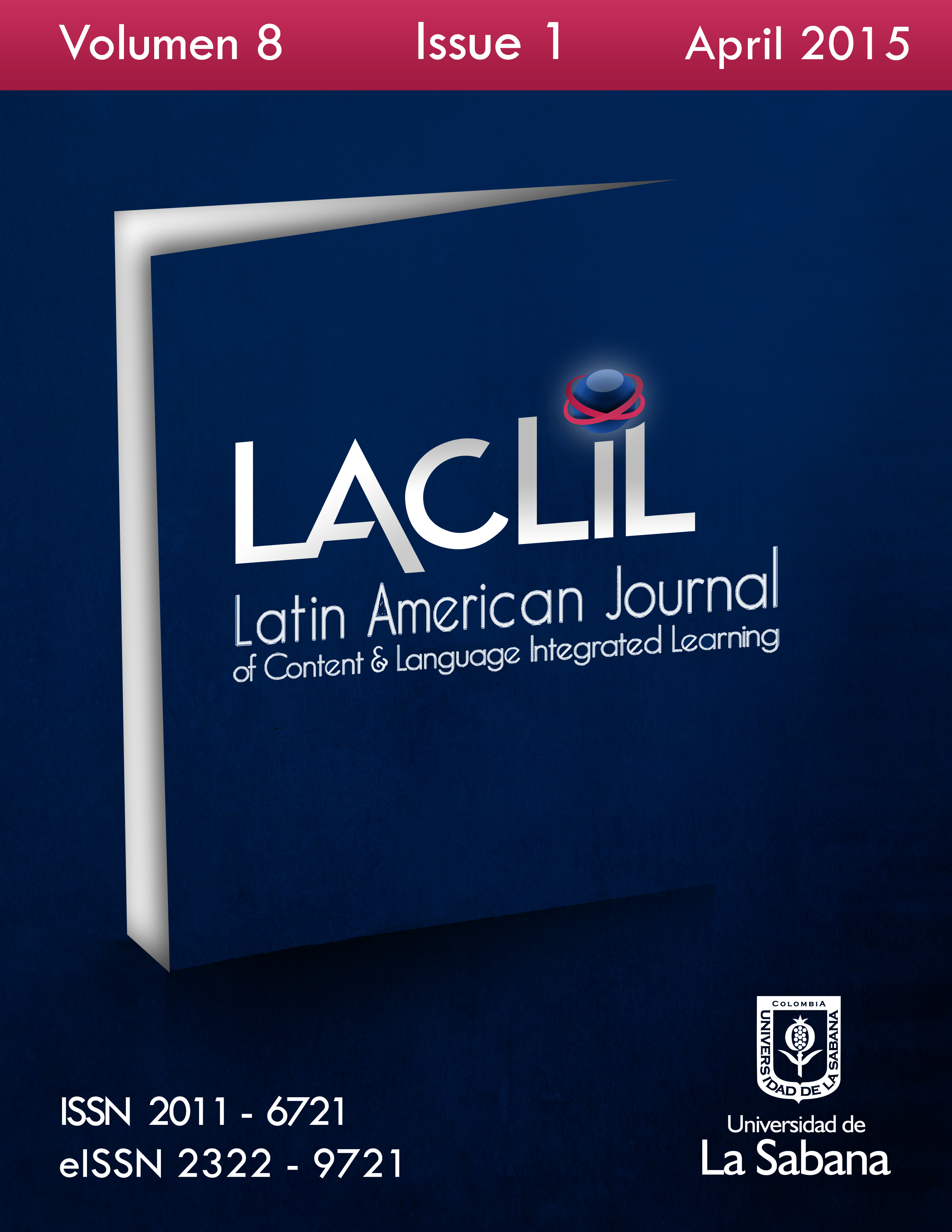Editorial introduction
DOI:
https://doi.org/10.5294/5351Abstract
Welcome to Volume 8, Issue 1 of the Latin American Journal of Content and Language Integrated Learning (LACLIL). This issue presents a variety of research endeavors on how content and language are being treated at different levels of education. Nowadays, the progression of foreign language teaching and each of its methods and approaches are taking place in a framework in which the term innovation is fundamental. The pace of globalization has been rapidly increasing, strongly affecting cooperation and communication across cultures. This is why it is very important that practitioners and researchers alike participate in making the teaching and learning process much more meaningful in the twenty-first century classroom. Therefore appreciating and analyzing our own cultural perspective against foreign cultural perspective are essential elements in the development of intercultural competenceDownloads
References
Bicer, A. (2003) Reflections on prospective language teachers on translation. Translation Journal, 7(3). Retrieved from http://translationjournal.net/journal/25reflections.htm
Byram, M. (2008): From foreign language education to education for intercultural citizenship: Essays and reflections. Clevedon, UK: Multilingual Matters.
Byram, M., & Risager, K. (1999): Language teachers, politics and cultures. Clevedon, UK: Multilingual Matters.
Cole, S. (1998) The Use of L1 in Communicative English Classrooms. The Language Teacher, 22(12). Retrieved from http://jalt-publications.org/tlt/articles/2439-use-l1-communicative-english-classrooms
Cross, R., & Gearson, M. (2013). Research and evaluation of the content and language integrated learning (CLIL) approach to teaching and learning languages in Victorian schools. Victoria, Australia: Melbourne Graduate School of Education. Retrieved from http://www.education.vic.gov.au/school/principals/curriculum/Pages/
clilvictoria.aspx
Dafouz, E., Núñez, B., Sancho, C., & Foran, D. (2007). Integrating CLIL at the tertiary level: Teachers’ and students’ reactions. In D. Wolff & D. Marsh (Eds.), Diverse contexts, converging goals: Content and language integrated learning in Europe (pp. 91-102). Frankfurt, Germany: Peter Lang.
Lasagabaster, D. (2011). English achievement and student motivation in CLIL and EFL settings. Innovation in Language Learning and Teaching, 5(1), 3–18. doi:10.1080/17501229.2010.519030
Lasagabaster, D., & Sierra, J. M. (2009). Language attitudes in CLIL and traditional EFL classes. International CLIL Research Journal, 1(2), 4–17. Retrieved from http://www.icrj.eu/12/article1.html
Maillat, D. (2010). The pragmatics of L2 in CLIL. In Language Use and Language Learning in CLIL Classrooms (pp. 39–58). doi:10.1075/aals.7.03mai
Massler, U. (2012). Primary CLIL and its stakeholders: What children, parents and teachers think of the potential merits and pitfalls of CLIL modules in primary teaching. International CLIL Research Journal, 1(4), 36-46. Retreived from http://www.icrj.eu/14/article4.html
Mehisto, P., & Asser, H. (2007). Stakeholder perspectives: CLIL programme management in Estonia. International Journal of Bilingual Education and Bilingualism, 10(5), 693–701. doi:10.2167/beb466.0
Petrocchi, V. (2006). Translation as an aid in teaching English as a second language. Translation Journal, 10(4). Retrieved from http://www.translationdirectory.com/article1199.htm
Sylvén, L. K. (2010). Teaching in English or English teaching? On the effects of content and language integrated learning on Swedish learners' incidental vocabulary acquisition. Göteborg, Sweden: University of Gothenburg
Sylvén, L. K. (2013). CLIL in Sweden – Why does it not work? A metaperspective on CLIL across contexts in Europe. International Journal of Bilingual Education and Bilingualism, 16, 301–320. doi:10.1080/13670050.2013.777387
Yung, K. (2003) Teaching English through English. English Language Education, 26, 49-70.
Downloads
Published
How to Cite
Issue
Section
License
This Journal and its articles are published under the Creative Commons CC BY 4.0 DEED Attribution 4.0 International license. You are free to: Share — copy and redistribute the material in any medium or format for any purpose, even commercially. Adapt — remix, transform, and build upon the material for any purpose, even commercially. The license cannot revoke these freedoms as long as you follow the terms of the license.








